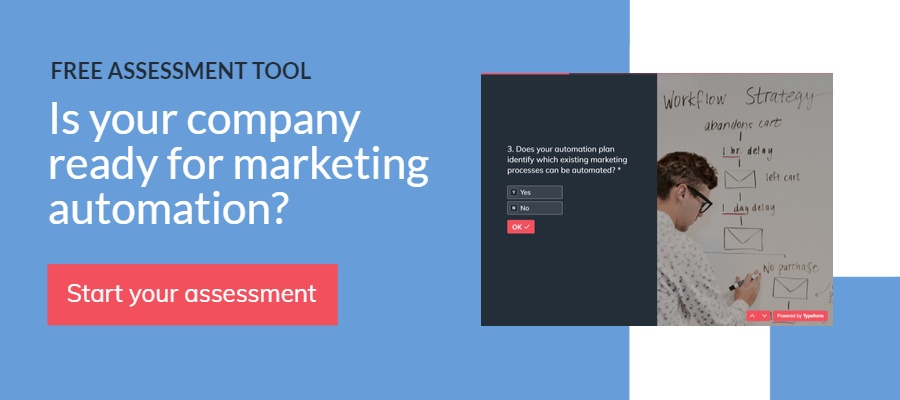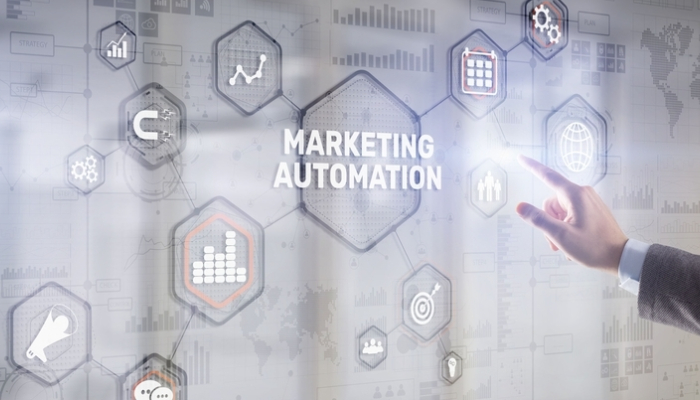This year, it’s more important than ever for organisations to strive for efficiency and effectiveness in their life sciences marketing strategy. As a result, more and more marketing departments are turning to marketing automation tools to achieve more. A marketing automation system is a powerful tool that can help life science companies improve their marketing efforts and drive business growth. By automating repetitive tasks, targeting specific groups of customers, and tracking the effectiveness of marketing campaigns, marketing automation systems can help life science companies create more effective marketing campaigns and achieve better results.
There are many benefits of marketing automation for life science marketers, including saving substantial amounts of administrative time, which results in cost savings. These systems also enable smarter, data-driven decision-making to improve performance. For example, by analysing customer data and tracking metrics such as click-through rates and conversion rates, marketing automation can help life science companies understand which marketing campaigns are working and which are not. By leveraging this data, businesses can capture learnings and optimise their marketing strategies for maximum impact to support business growth.
There are a variety of common use cases for marketing automation that life science organisations can benefit from. But which is best for you ultimately depends on the specific goals and objectives of your business and marketing department, as well as your available resources and target audience. To help you decide, in this blog post we explore 14 key use cases of marketing automation and discuss how they can help life science businesses to grow and improve their return on marketing investment (ROMI). If there is a particular use case you’re interested in learning more about, you can skip ahead using the links below.
Note: If you are a visual learner, our CEO Dr Paul Avery covered the key use cases that we’ll go through in this blog in a 30-minute webinar on ‘How life science marketers can leverage marketing automation to achieve more with less’, which we recorded and have made available to access via our resources section.
Skip ahead:
- Email lead nurturing
- Dates to trigger actions
- Personalised website content
- Chatbot interactions
- Content scheduling and publishing
- Gather customer feedback at scale
- Manage paid ads at scale
- Improve sales, minimise cart abandonment
- Internal communications and notifications
- Predictive lead scoring
- Automate customer onboarding
- Social media monitoring and response
- GDPR administration
- Surface customer/market insights and trends
1. Email lead nurturing
Email lead nurturing is one of the most popular use cases for marketing automation. This involves setting up workflows that can drip-feed content to different prospects or customers in your contact database based on a variety of criteria, including their buyer persona, segment, or recent content they've viewed. Workflows can be as simple or as complex as required depending on the complexity of your company’s lead to conversion process. For example, suppose your life science product or service is particularly complex. In that case, more information and relevant content may be required to nurture a lead into a customer, resulting in a longer email nurture workflow. For more information on the three pillars needed for successful life science lead nurturing, check out our blog.
One of the main benefits of using marketing automation for email lead nurturing is the ability to segment your audience based on a buyer persona or segment. By doing so, you can deliver relevant and personalised content to specific groups of people, which can help to increase the effectiveness of your campaigns. If you have a group of prospects who are interested in a specific feature of your product, for example, you can create a targeted email campaign that focuses on that feature and deliver it specifically to that audience segment, rather than sending it to your entire database, some of whom it might not be relevant for.
In the life science industry, we have found that email lead nurturing for life sciences can be particularly effective for promoting new products and services, and for keeping customers informed about industry developments and updates. By providing relevant and valuable information, life science companies can position themselves as thought leaders and experts in their field whilst building trust and loyalty with their customers.
Marketing automation can also help to automate repetitive email tasks such as sending follow-up emails. By setting up workflows, life science companies can ensure that the right message is delivered at the right time, without the need for manual intervention. For instance, if a potential customer downloads an eBook from your website, you can set up a workflow that delivers the eBook and then sends timely follow-up emails with additional relevant content based on the recipients’ actions over the next week or two.
But that’s not all. Life science marketers can also use the email analytics tools that marketing automation systems provide to measure the success of email lead nurturing campaigns by tracking metrics such as the open and click-through rates of emails, as well as the conversion rates of their campaigns. This data can be especially valuable when used to optimise future campaigns and improve their effectiveness.
If you are new to email lead nurturing and not sure how to begin, it may be helpful to work with a life science specialist marketing agency that has a track record of success with this type of marketing.
2. Dates to trigger actions
Leveraging dates to trigger automated actions is an increasingly popular way for organisations to maximise their marketing efforts and boost customer engagement. By using dates associated with customers or prospects, such as birthdays and work anniversaries, companies can use automation to trigger activities such as personalised emails content updates, and even handwritten cards.
By using marketing automation to record dates associated with different customer profiles, life science companies can use tools such as Handwrytten to automate the delivery of personalised notes at scale. For example, if businesses have access to customer birthdays or the date of their first purchase, they can use automation to send out heartfelt handwritten cards to their customers, giving the impression that the marketing and sales team went out of their way to write individual notes. This powerful tool can help build strong relationships and customer loyalty; however, it must be used responsibly to ensure that customers don’t feel overwhelmed or spammed.
Another benefit of using date-based triggers in marketing automation is that it allows organisations to schedule their marketing campaigns months in advance and ensure that all of their campaigns are timed perfectly to coincide with key events or milestones. Aligning campaigns to key dates can help to increase their effectiveness by capitalising on times when target audiences are more likely to engage with your activities.
3. Personalised website content
Another powerful use case for marketing automation in the life sciences is personalised website content. Using cookies, you can track when someone has filled out a form on your website and then show them personalised content the next time they return. The content shown can be based on their past behaviour, such as the pages they've visited or resources they’ve downloaded.
Using cookies to help understand customers’ specific needs and interests enables life science companies to tailor messaging and offers on their website using marketing automation. Adopting such an approach can help to significantly increase prospect engagement and conversion, and customer loyalty, making them more likely to remain a customer or rebuy in the future.
4. Chatbot interactions
Chatbots have become increasingly popular in recent years as they provide quick and convenient assistance to customers. By automating these conversations, businesses can save time and money by streamlining customer service inquiries and removing the need for individuals within the company to respond manually to every question.
Through effective workflows that feed the automated chatbot, companies can provide customers and prospects alike with an efficient and engaging customer service experience. And when chatbots are unable to help or get confused, they can forward inquiries to a real human to ensure assistance is still provided. In the life sciences, this makes chatbots particularly powerful — with chatbots providing assistance to simple enquiries, customer support team members can dedicate more time to respond to complex queries, which are commonplace within the industry.
5. Content scheduling and publishing
With marketing automation tools, businesses can schedule content publication at a specific date and time. Many marketing automation tools also allow you to schedule additional actions to take place once your content goes live, for a cohesive campaign. For example, you can schedule your blog post and then automatically share a summary of the post on LinkedIn and Twitter on your business profiles. You can also set up the system to automatically send a summary email to a specific segment of your database, which can help to increase visibility and engagement with your life sciences content. Using tools to greatly reduce the administrative burden of content publishing, can save you valuable time and resources, which can be invested in more strategic activities instead.
Additionally, marketing automation can also help to improve the effectiveness of your content. Some automation tools are sophisticated enough that you can schedule and publish your content at specific times across multiple time zones, so that it reaches the right audience at the right time, increasing visibility and engagement.
6. Gather customer feedback at scale
With the help of marketing automation tools, life science companies can easily and efficiently collect customer feedback at scale on a variety of topics, including customer loyalty and satisfaction, and market trends. The feedback gathered can then be used to improve products and services, increase customer satisfaction, and ultimately drive business growth.
By automating the survey process, you can quickly and easily create, and send, targeted surveys to different segments of your database. But why go to the effort of developing multiple surveys instead of sending one? Simply, if surveys are tailored to specific customers or customer segments, you will likely receive more feedback. After all, aren’t you more likely to answer a survey that is relevant to you?
If you haven’t sent surveys before, you may be wondering where to start. A simple and effective way to leverage automation systems for gathering customer feedback is by asking for reviews. Sending a Net Promoter Score (or NPS) survey is a great place to start. If a customer responds with a high score of 9 or 10, then you can automatically follow up with a request for a review. Alternatively, if they provide a lower score, you can choose not to follow up for a review, but instead, contact the customer directly to support any issues they may be having. Following this approach has two main benefits: 1) You can be confident that most of the reviews you receive will be positive, as customers who are less satisfied with your product or service can be attended to before receiving a review request. 2) You can monitor negative feedback for trends and use this to inform your product and service development to make sure your offerings are optimised to best meet market needs.
7. Manage paid ads at scale
Managing paid ads at scale as part of your PR strategy can seem daunting, but with the power of marketing automation and artificial intelligence (AI), it’s never been easier. By using programmatic advertising tools, you can manage multiple campaigns across a range of networks and have the software automatically bid for you. The result? You save time and can be confident your ads are reaching the right audience at the right time.
One particular benefit of using marketing automation for paid ads is the ability to test and swap out copy and creative content based on performance. For life science companies that have a variety of different products, like reagents and consumables, this can be a game changer. You no longer need to spend hours writing copy for each ad, instead, you can give the software a few variations and let it test them for you.
Google Ads is also moving in this direction, with their software allowing you to give it headline variations and then swapping them out based on clicks. This type of testing and optimisation will become even more powerful in the future as these platforms gather more data and integrate it with your own data. It’s certainly an exciting time to be part of the paid advertising revolution, and soon, you will know what type of people are most likely to buy from you before they are even considering making a purchase.
8. Improve sales, minimise cart abandonment
A useful marketing automation use case for e-commerce life science businesses is cart abandonment: when customers add items to their cart, but don’t complete their purchase. With marketing automation, it’s possible to set up automated email campaigns that target customers who abandon their cart. These emails can include a gentle reminder about the items left in their cart, as well as a special offer or discount code to encourage them to complete their purchase. Simple? Yes. Effective? Incredibly so.
For life science companies that sell products like antibodies and reagents, cart abandonment can be a significant problem. These products are often high-value items and even a small increase in sales can have a big impact on the company’s bottom line. Setting up cart abandonment campaigns with marketing automation is a quick and easy process that can generate instant results, improve sales and grow your business.
9. Internal communications and notifications
Marketing automation can overcome one of the biggest challenges in life science communications — the disconnect between sales and marketing teams. Used effectively, automation tools improve internal communications and notifications within a company to ensure that high-quality leads are handled in an efficient and effective manner. The results of streamlining the ‘smarketing’ process in this way can be staggering. In fact, companies with aligned marketing and sales processes have reported up to 208% more returns from their marketing efforts, as well as a 32% YoY revenue growth.
But how can your life science marketing and sales teams use marketing automation systems in practice? One key benefit of using marketing automation for internal communications is the ability for marketers to automatically notify sales reps when a lead is generated in their region. This allows the sales rep to follow up with the lead in a timely manner and increases the chances of conversion.
Another simple yet effective method of utilising marketing automation for the benefit of both sales and marketing is for marketers to create templated sales emails using automation systems that sales reps can quickly and easily personalise themselves before sending. Using templated emails in this way can help bring consistency to the sales approach, as well as efficiency. When emails are sent through automation systems, they can also be tracked allowing sales and marketing to analyse the success of the emails as well as the journey from lead to customer.
One particularly important benefit of using marketing automation for internal communications is the ability to improve lead scoring (more on this in the next section). By automating the process of gathering feedback from the sales team, it’s possible for both sales and marketing to gain valuable insights into which leads are most likely to convert and as a result, the sales reps can focus their resources on those leads. If sales and marketing resources are focused on the most promising leads, the overall efficiency and effectiveness of the sales process is likely to increase, resulting in more customer conversions, and maximising revenue.
10. Predictive lead scoring
Speaking of lead scoring, as life science companies generate more leads, it becomes increasingly difficult to manually score each one. This is where marketing automation comes in — it allows companies to score leads at scale, without the need for manual intervention.
There are a number of different ways to conduct lead scoring, but at BioStrata, we’re advocates for simple yet effective methods. For example, a ‘hot’ lead suitable for sales follow-up would be someone who has raised their hand and asked to speak to sales by filling in a contact us form on your website. Whereas a ‘cold’ lead requiring further nurturing from marketing could be someone who downloads an awareness stage whitepaper.
However, as companies generate more leads, they need to start thinking about how they are going to score them at scale. A more complex lead scoring mechanism, like predictive lead scoring, may be necessary to help you prioritise leads and achieve higher lead qualification rates. While these lead scoring methods can be useful under certain conditions, they can be difficult to manage without an automation system.
One of the ways that automation can improve lead scoring is through the use of artificial intelligence (AI). AI can be used to track the journey of leads from contact to close and improve your lead scoring model based on what it sees happening in the real world. For life science companies with lots of contacts and customers, this is particularly valuable as they will be able to enrich their lead scoring model with real-world evidence, allowing them to better understand and qualify their leads.
11. Automate customer onboarding
Marketing automation can be a valuable tool for improving your customer onboarding process. Robust onboarding processes are an essential part of delighting customers and help ensure a smooth transition from the sales team to ongoing customer support.
Customer onboarding is a key step in any business model, but it’s critical for life science companies that operate on a subscription model. For example, in the software as a service (SaaS) industry, a robust onboarding process is essential for retaining customers who take free trials before converting into paying customers. If the free trial customer has a positive initial experience, then they’ll be more likely to purchase the paid product and remain a subscriber.
Using automation tools, you can guarantee that all customers have a consistent onboarding experience. Marketers can utilise automation to create email workflows for new customers that send a steady stream of welcome emails, starter guides and tutorial videos at scale in a consistent and timely manner. By automating this process, marketers can free up time and resources that would have otherwise been spent on sending these communications manually, to focus on more important, strategic tasks.
In addition, marketing automation can help marketers to identify and understand customer behaviour, which can help you to improve the onboarding process and increase customer retention. By analysing customer behaviour through automation data, you can identify areas of the onboarding process that need improvement and make changes accordingly that will lead to a better experience for your customers.
12. Social media monitoring and response
Traditionally, social media monitoring was a time- and resource-intensive task. Now, marketers can use marketing automation tools to monitor and automatically respond to mentions of their brand on social media. As a result, life science organisations using such tools can automatically respond to comments in real-time without relying on social media marketers being available across different time zones.
Imagine a customer posts on social media that they had a terrible experience with your life science company’s customer service team. A marketing automation software platform could automatically identify this comment and send a message back, apologising for the bad experience and inviting the customer to contact customer service for assistance. This type of automated response can be especially valuable for brands that receive a lot of comments on social media. Managing customer engagement on social media at scale can be incredibly difficult, but with the help of marketing automation, it becomes a much more manageable task.
In addition, by monitoring and responding to mentions of your brand on social media, you can also gain valuable insights into customer sentiment and identify areas where your brand could improve. Marketing automation software can identify customer sentiment by recognising positive or negative words, for example, positive words may include ‘love’, ‘amazing’ or ‘best’ whereas negative words may include ‘bad’, ‘hate’ or ‘worst’. You will need to be mindful of the context around the comment when automating this process. However, by monitoring these mentions, it gives you the chance to build stronger relationships with your customers and improve your company’s overall customer experience.
13. GDPR administration
GDPR, or General Data Protection Regulation, has been an ongoing challenge for EU marketers since 2016. But rest assured, marketing automation tools can make it much easier to comply with the regulations allowing life science marketers to avoid costly fines and focus on other important aspects of the business.
When it comes to assuring compliance with GDPR, marketing automation systems can help you:
- Simplify the management of opt-ins for people who visit your website and fill in forms
- Keep track of who has opted out of communications and ensure that you don't accidentally email them
- Automate GDPR-related email communications, such as privacy policy updates
- Keep track of customer data to ensure you are collecting and storing the data in accordance with guidelines
By automating the above, you can save significant time and resources that would have otherwise been spent on repetitive, manual tasks. With budgets getting tighter, being able to invest these resources in other marketing activities, can make a significant difference to the value your marketing can deliver to your life science organisation.
14. Surface customer/market insights and trends
Our final use case covers using marketing automation tools to elucidate customer or market insights and trends. In the life sciences industry, staying ahead of the competition and understanding your customers is more important than ever. Marketing automation can be a powerful tool to help you achieve this.
One of the key benefits of using marketing automation for this purpose is that it can help you uncover insights and trends that you wouldn't find manually. For example, Crayon, an automated market trends tool, provides real-time insights, such as when one of your competitors runs a new ad campaign or updates the messaging on your website. By keeping abreast of such updates, you can quickly pivot your own messaging as required to maintain a competitive edge.
Another example of using automation for market insights is Outreach Cloud, which allows you to track customers from click to close. Gathering interaction data at scale allows you to truly understand what content works best and which channels are most effective for each type of customer and buyer persona. By analysing your customer data, you can turn it into actionable insights that you can use to improve your overall life science marketing strategy.
How to start using marketing automation to maximise your marketing efforts
Marketing automation is transforming the life sciences industry in a multitude of ways. From email lead nurturing and managing paid ads at scale, to chatbot interactions and personalised web content, marketing automation is making it easier to engage with customers and improve their overall experience. By effectively using the tools available, you can make better-informed, data-driven decisions, invest resources in the highest-value activities and maximise the value your marketing campaigns deliver. The result? An effective marketing team that truly helps your business grow.
If your life science company would like to start utilising marketing automation and is looking for the best tool to suit your particular business needs, check out our blog that discusses 18 marketing automation software tools that can help save you time and money.
Whether or not you are already using some automation tools, it’s useful to know what the common life science marketing automation pitfalls are and how to avoid them — we’ve covered our top 6 in this blog post.
Finally, to help life science organisations plan for the successful implementation of marketing automation, we’ve put together a 10-step marketing automation ‘readiness’ tool. Simply fill in the short questionnaire for advice and recommendations on how to ensure your marketing automation project is as smooth and successful as possible.





